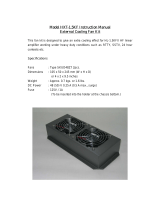
1
Table Of Contents
Important Safety Information ..................................................................................................................................... 2-4
Introduction ................................................................................................................................................................... 5
Model and Serial Number Location .............................................................................................................................. 5
Unit Identication .......................................................................................................................................................... 6
Performance Data and Specications .......................................................................................................................... 7
Installation Information/Sleeve Dimensions/Circuit Rating ........................................................................................... 8
Electrical Data ............................................................................................................................................................... 9
Before Operating the Unit ............................................................................................................................................10
Kuhl Control Options ....................................................................................................................................................11
Control Panel and Display Identication ......................................................................................................................12
Control Panel Operation Instructions ......................................................................................................................13-19
Remote Control Operation ...................................................................................................................................... 20-21
Unit Operation ............................................................................................................................................................ 22
Electronic Control Sequence of Operation ............................................................................................................ 23-27
Fan Operation ............................................................................................................................................................. 28
Removing the Front Cover and Unit Chassis ................................................................................................................ 29
Replacing the ID Coil Thermistor ................................................................................................................................ 30
Replacing the Control Board ....................................................................................................................................... 30
Airow Selection and Adjustment ............................................................................................................................... 31
Components Testing .............................................................................................................................................. 32-33
Testing the User Interface and Control Board ........................................................................................................... 34
..
Refrigeration Sequence of Operation .......................................................................................................................... 35
R410A Sealed System Repair Considerations ........................................................................................................... 36
Sealed Refrigeration System Repairs .................................................................................................................... 37-40
Hermetics Components Check ................................................................................................................................... 41
Reversing Valve Description/Operation ...................................................................................................................... 42
Testing the Coil ........................................................................................................................................................... 43
Checking the Reversing Valve ............................................................................................................................... 43-44
Compressor Checks .............................................................................................................................................. 45-46
Compressor Replacement ..................................................................................................................................... 47-48
Routine Maintenance ............................................................................................................................................. 49-52
Service and Assistance/Avalaible Accessories .......................................................................................................... 53
How to Check and Erase the Diagnostic Codes ........................................................................................................... 54
Error Codes and Alarm Status .................................................................................................................................... 55
Test Mode ................................................................................................................................................................... 56
Thermistors' Resistance Values .................................................................................................................................. 57
Performance Test Data Sheet ..................................................................................................................................... 58
Troubleshooting ..................................................................................................................................................... 59-68
Electronic Control Board Components Identication & Thermistor Voltage ................................................................... 69
Electronic Control Conguration Instructions .............................................................................................................. 70
Wiring Diagrams .................................................................................................................................................... 71-79
Remote Control Replacement Instructions ........................................................................................................... 80-81
User Interface Service Kit ........................................................................................................................................... 82
Parts Section ......................................................................................................................................................... 83-90
Addendum 1 ............................................................................................................................................................... 91
Warranty ...................................................................................................................................................................... 92
Authorized Parts Depots .............................................................................................................................................. 93
Technical Support Contact Information.........................................................................................................................93






















